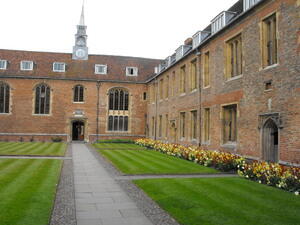The proposals have provoked angry protests by students and senior pupils at schools. In part this is because the Conservatives’ partner in the coalition, the Liberal Democrats, had promised at last year’s election to oppose any increase in tuition fees. So there is bitterness at their broken promises. The then-Labour government and the then-Conservative opposition had stitched up a deal to take the issue of higher education funding out of the election. They agreed to set up a review that would make recommendations once the election was safely out of the way. The man entrusted with the review was the head of British Petroleum. Obviously anyone capable of overseeing BP’s catastrophic oil spill in the Gulf of Mexico would know what should be done to higher education. A similar cynical deal had been successfully used before the 1997 election – after which Tony Blair’s New Labour government was able to introduce university tuition fees for the first time.
But what’s education for?
So politicians mislead voters and right-wing politicians favour market solutions. No great surprises there. The more fundamental question is what is higher education for?
It was about 50 years ago that I first became aware that universities existed. As I approached the statutory minimum school leaving age, the school simply kept me on and moved me to the next stage. However, by the time I got to university a couple of years later, I had a better understanding. First of all, I knew I was privileged to be there. In those days only about 7% of school leavers went to university, and my parents and relations had all left school at 14. I felt that my place had been earned on merit – but also I recognised that I only there because of the Welfare State.
At university I quickly sensed the purpose of higher education. It was about the continuity of learning which was ensured by the freedom to challenge inherited truths. The tutorial system (2 students and one teacher) required you to develop and defend your arguments, to prepare your essay beforehand then to think on your feet. Ideas, argument, evidence, analysis, critical enquiry and intellectually demanding work were the very essence of the university.
A few years later that perspective carried me into an academic career. Universities were basically still run by their staff (albeit that Professors clearly had more power than other academics). Thus in the early 1970s, the challenge was to democratise the process of university governance through involvement of students and more junior staff in decision making about course content. The freedom to do your own research on any topic that interested you was still integral to the role of the academic.
Into the 1980s the UK system of higher education remained relatively unchanged. Yes, more people were passing through higher education, but they were still a relatively small minority who had demonstrated academic ability. They received grants from government who also paid the universities to teach them. Thus full-time students were just that – full-time; they might work in the vacations, but during term time it was not unreasonable to expect them to be on call at any time and working roughly a 40 hour week. They were taught in relatively small groups, generally by staff most of whose time was taken up by teaching. When in 1980, the government told the universities they would get less money the next year because of a difficult economic situation, the response was “OK, then we just have to take less students”.
Education factories
Things began to change in the late 1980s. Having gone through a phase of squeezing universities, government opted to expand the numbers going through higher education. It was a time of concern about youth unemployment and increasing angst from middle-class voters about the career prospects of their children. The political stroke of genius was to deliver significant growth in university places without anything like a proportional rise in costs to the taxpayers. Quite simply, government decided that universities could deliver “efficiency gains”, so needed less money per student each year. To help them achieve these gains, pay rises for academics were kept down. If only the same alchemy could have been worked with the health service or the defence budget, or even schools, where teacher-pupil ratios stayed roughly the same while the same ratios in universities doubled over a period of 10-15 years.
The second masterstroke was to play on the vanity of academics – a sure winner. They would be tested by their peers for the quality of their teaching and of their research. League tables were produced and those at the top for research got more funds than those in the relegation places. The wheeze worked perfectly. Universities moaned that they were underfunded, (and academics that they were underpaid), but at the same time they proudly proclaimed that they were doing more, better research and much better teaching than ever before. No need for more money then.
Student support was also squeezed. Combined with their new levels of expectation for consumer comforts and designer clothes, this put pressures on students to work to fund their lifestyle through the College years. The academics, faced with more students and a wider ability range, realised they could not teach as intensively as in the past. Furthermore, research was a better earner than teaching. Survival required more research and so less time could be spent teaching and marking. Thus there developed a kind of unwritten consensus that less would be given to students and less expected of them: but, in another wave of the magic wand, the students would achieve better results at the end of their programmes.
In this process of growth, the idea developed that going to university – and getting a high-grade result at graduation - was a right not a privilege or something to be earned on merit. University became a lifestyle choice defined by peer group pressure as much as by parental aspirations. Almost half of the age cohort now went into higher education.
Meanwhile the management of universities changed. Instead of being run by staff and their representatives, like other factories they came to be controlled by professional managers. Naturally these people had to be paid high incomes to be attracted and retained, with incentives in the form of bonuses for performance (e.g. increased student recruitment).
So what is a university for?
Today the purpose of a university is defined by bankers. Getting a degree is a commodity on which a student can speculate. Borrow money and use it to buy (at market rates) – the prospect of a well-paying job. This same formula created the sub-prime housing market in USA, that collapsed and triggered the economic crisis. Poor people were encouraged should to borrow money to buy a house, speculating that it would eventually be worth much more than they paid for it. When the houses were found to be worthless, the credit ran out, the debts kicked in and the banks told us all that we had to bail them out. What will happen when degrees don’t delivered the expected returns? Already we see graduate unemployment and under-employment on the rise.
Meanwhile, in the UK at least, there is another narrative. This is about universities as facilitators of – or, more often, barriers to – social mobility. Despite more and more students passing through higher education, access to the “elite” universities has become no easier for students from poorer backgrounds than it was in my own long-distant student days. Much the same could be said for becoming a member of the government: millionaires and the privately educated continue to be hugely over-represented there too, but it is the universities who are told they must change, not the political institutions.
The really significant social change that universities have delivered in the past generation has been the dramatic increase in participation of young women from middle-class backgrounds. The kind of girls who, 50 years ago would have expected to become secretaries or teachers then drop out of the labour market when they had children, now get degrees and build professional careers. This has transformed workplaces, household incomes, even cities and has helped turbo-drive the economy through unprecedented levels of consumption. Universities have also become significant players in a regional economy. Research into science and technology holds the prospect of innovation and commercial spin-offs.
Thus, the impacts of higher education are not limited only to those who pass through the system. There is a public interest case for taxpayer support to universities. However, if higher education is to be organised on a bankers’ model, then why stop there? Doesn’t school also give their pupils better prospects? Why should the taxpayer pick up that bill when a school’s customers could take out a bank loan to learn how to read a contract, write their name at the bottom of it and calculate their monthly repayments ?

